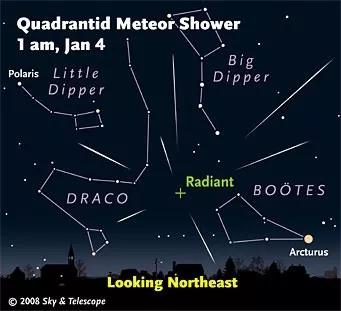View Other Topics.
 Jan 3, 2020
Jan 3, 2020
Image: Quadrantid meteor shower map - skyandtelescope.com
In 2020, the Quadrantids will peak on the night between Jan 3–4 according to timeanddate.com
January Meteor Shower
The Quadrantids are usually active between the end of December and the second week of January, and peak around January 3-4. Unlike other meteor showers that tend to stay at their peak for about two days, the peak period of the Quadrantids only lasts a few hours.
Asteroid 2003 EH1
The shower owes its name to the now-defunct constellation Quadrans Muralis. The constellation was left off a list of constellations drawn out by the International Astronomical Union (IAU) in 1922, but because the shower had already been named after Quadrans Muralis, its name was not changed. The Quadrantids is also sometimes called Bootids after the modern constellation, Boötes.
The Quadrantids are associated with asteroid 2003 EH1. The asteroid takes about 5.5 years to orbit around the Sun.
What Time Does the Meteor Shower Peak?
The table is updated daily and shows the position of the Quadrantids radiant in the sky for the upcoming night. Use the date drop down above the Interactive Meteor Shower Sky Map to change dates.
Quadrantids meteor shower for New York (Night between January 3 and January 4)
Time Azimuth/Direction Altitude
Fri 5:00 pm 329°North-northwest 10.8°
Fri 6:00 pm 337°North-northwest 5.6°
Fri 7:00 pm 346°North-northwest 2.2°
Fri 8:00 pm 356°North 0.6°
Fri 9:00 pm 6°North 0.7°
Fri 10:00 pm 15°North-northeast 2.6°
Fri 11:00 pm 24°North-northeast 6.4°
Sat 12:00 am 33°North-northeast 11.7°
Sat 1:00 am 40°Northeast 18.4°
Sat 2:00 am 46°Northeast 26.2°
Sat 3:00 am 52°Northeast 34.8°
Sat 4:00 am 56°Northeast 44.0°
Sat 5:00 am 59°East-northeast 53.6°
Sat 6:00 am 59°East-northeast 63.4°
Sat 7:00 am 53°Northeast 73.0°
Direction to see the Quadrantids in the sky:
Azimuth is the direction, based on true north; a compass might show a slightly different value.
Altitude is height in degrees over horizon.
How to See the Quadrantids
You don't need any special equipment or a lot of skills to view a meteor shower. Even though all you really need is a clear sky, lots of patience, and our handy Interactive Meteor Shower Sky Map with a visibility conditions meter to see a meteor shower, the following tips can help maximize your shooting star viewing experience.
Find a secluded viewing spot, away from the city lights. Once at the venue, your eyes may take 15 to 20 minutes to get used to the dark.
Dress for the weather, and make sure you are comfortable, especially if you plan to stay out long. Bring a blanket or a comfortable chair with you—meteor watching can be a waiting game.
Once you have found your viewing spot, lie down on the ground and look up in the direction of the radiant. Use our Interactive Meteor Shower Sky Map or the table above to find the current direction of the radiant in the sky.
Tags:
#quadrantid#meteor#shower,#astrology,#starzpsychics.com,#starz#advisors
Quadrantid Meteor Shower.

Image: Quadrantid meteor shower map - skyandtelescope.com
In 2020, the Quadrantids will peak on the night between Jan 3–4 according to timeanddate.com
January Meteor Shower
The Quadrantids are usually active between the end of December and the second week of January, and peak around January 3-4. Unlike other meteor showers that tend to stay at their peak for about two days, the peak period of the Quadrantids only lasts a few hours.
Asteroid 2003 EH1
The shower owes its name to the now-defunct constellation Quadrans Muralis. The constellation was left off a list of constellations drawn out by the International Astronomical Union (IAU) in 1922, but because the shower had already been named after Quadrans Muralis, its name was not changed. The Quadrantids is also sometimes called Bootids after the modern constellation, Boötes.
The Quadrantids are associated with asteroid 2003 EH1. The asteroid takes about 5.5 years to orbit around the Sun.
What Time Does the Meteor Shower Peak?
The table is updated daily and shows the position of the Quadrantids radiant in the sky for the upcoming night. Use the date drop down above the Interactive Meteor Shower Sky Map to change dates.
Quadrantids meteor shower for New York (Night between January 3 and January 4)
Time Azimuth/Direction Altitude
Fri 5:00 pm 329°North-northwest 10.8°
Fri 6:00 pm 337°North-northwest 5.6°
Fri 7:00 pm 346°North-northwest 2.2°
Fri 8:00 pm 356°North 0.6°
Fri 9:00 pm 6°North 0.7°
Fri 10:00 pm 15°North-northeast 2.6°
Fri 11:00 pm 24°North-northeast 6.4°
Sat 12:00 am 33°North-northeast 11.7°
Sat 1:00 am 40°Northeast 18.4°
Sat 2:00 am 46°Northeast 26.2°
Sat 3:00 am 52°Northeast 34.8°
Sat 4:00 am 56°Northeast 44.0°
Sat 5:00 am 59°East-northeast 53.6°
Sat 6:00 am 59°East-northeast 63.4°
Sat 7:00 am 53°Northeast 73.0°
Direction to see the Quadrantids in the sky:
Azimuth is the direction, based on true north; a compass might show a slightly different value.
Altitude is height in degrees over horizon.
How to See the Quadrantids
You don't need any special equipment or a lot of skills to view a meteor shower. Even though all you really need is a clear sky, lots of patience, and our handy Interactive Meteor Shower Sky Map with a visibility conditions meter to see a meteor shower, the following tips can help maximize your shooting star viewing experience.
Find a secluded viewing spot, away from the city lights. Once at the venue, your eyes may take 15 to 20 minutes to get used to the dark.
Dress for the weather, and make sure you are comfortable, especially if you plan to stay out long. Bring a blanket or a comfortable chair with you—meteor watching can be a waiting game.
Once you have found your viewing spot, lie down on the ground and look up in the direction of the radiant. Use our Interactive Meteor Shower Sky Map or the table above to find the current direction of the radiant in the sky.
Share this article with friends!
Tags:
#quadrantid#meteor#shower,#astrology,#starzpsychics.com,#starz#advisors






